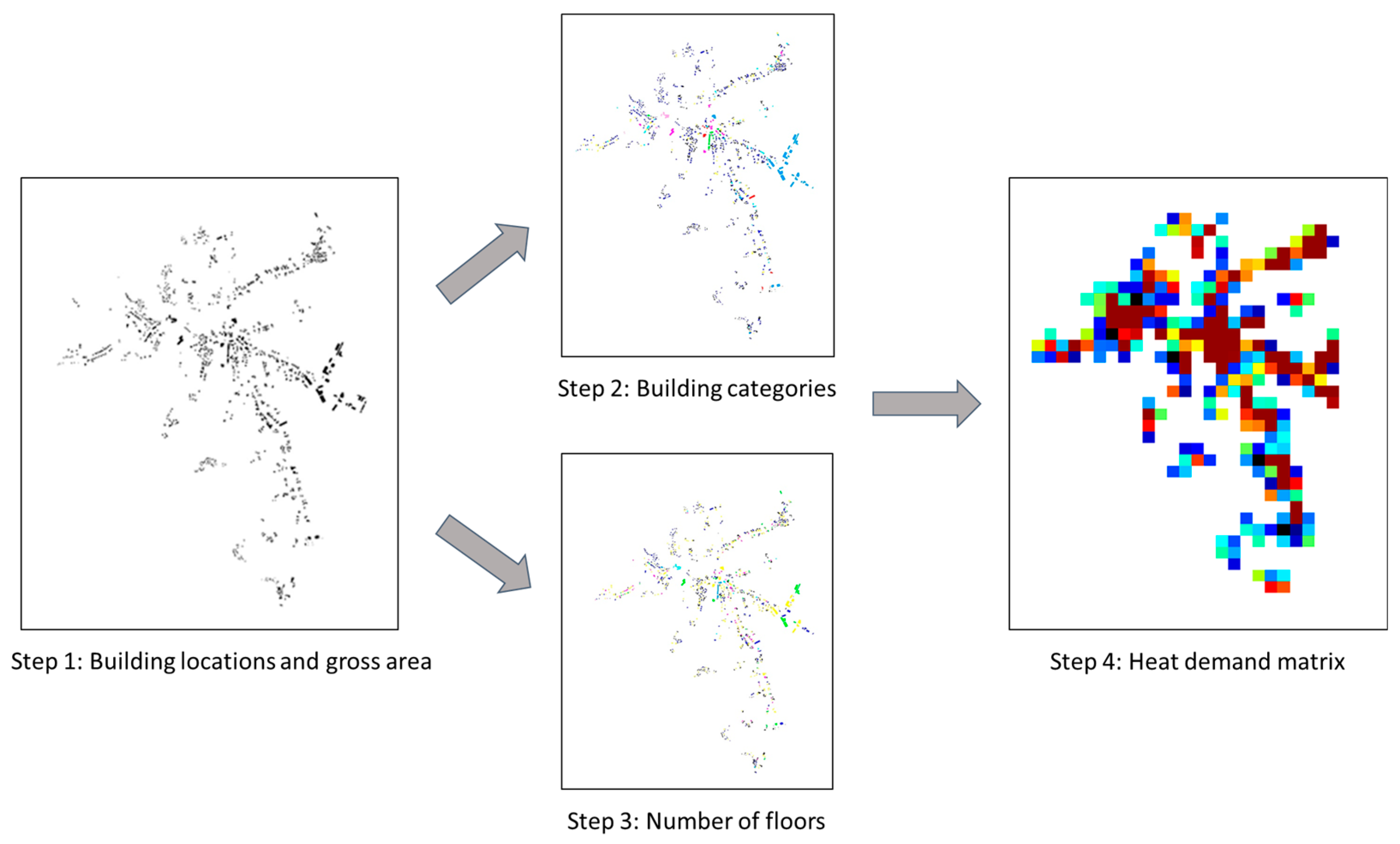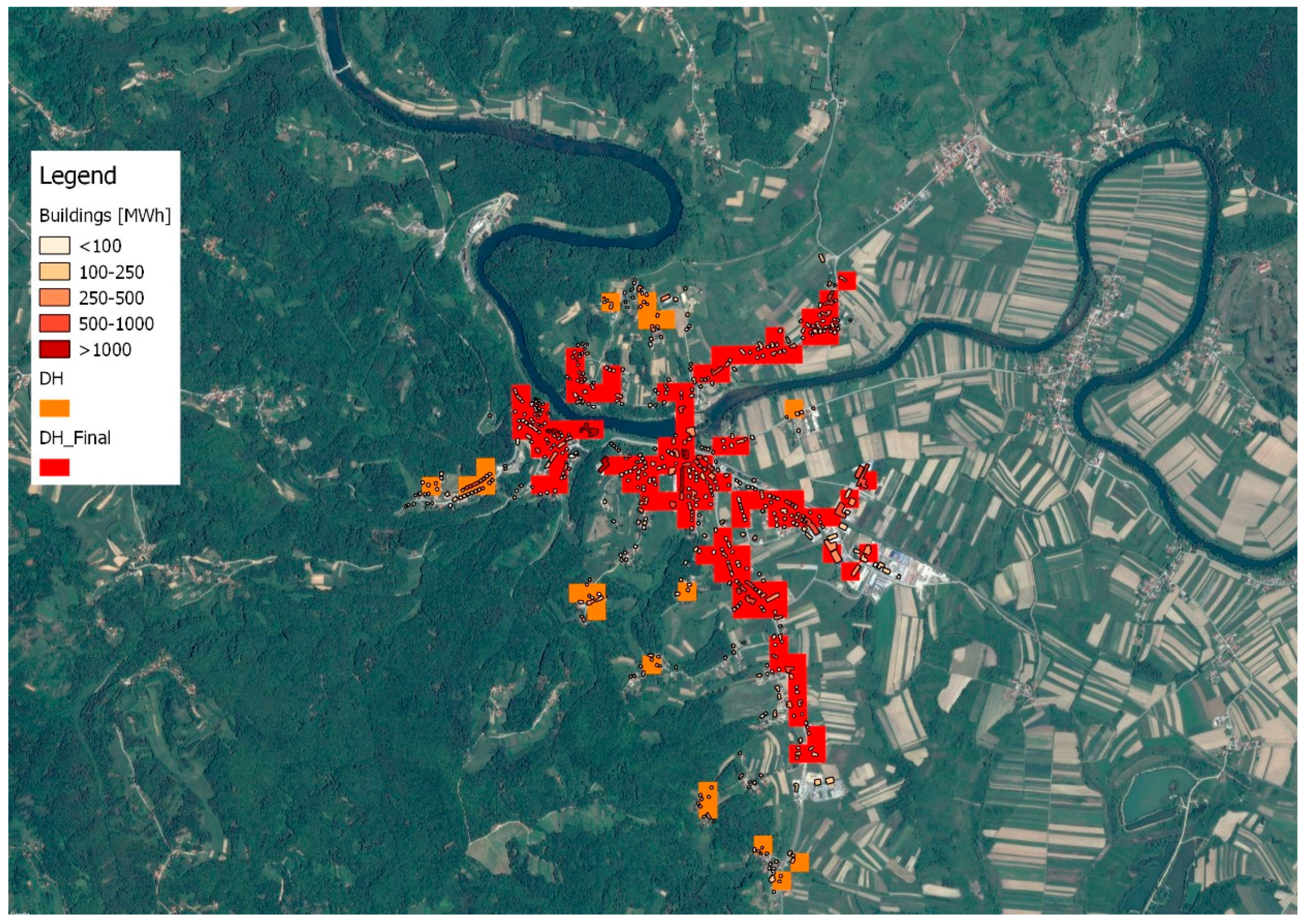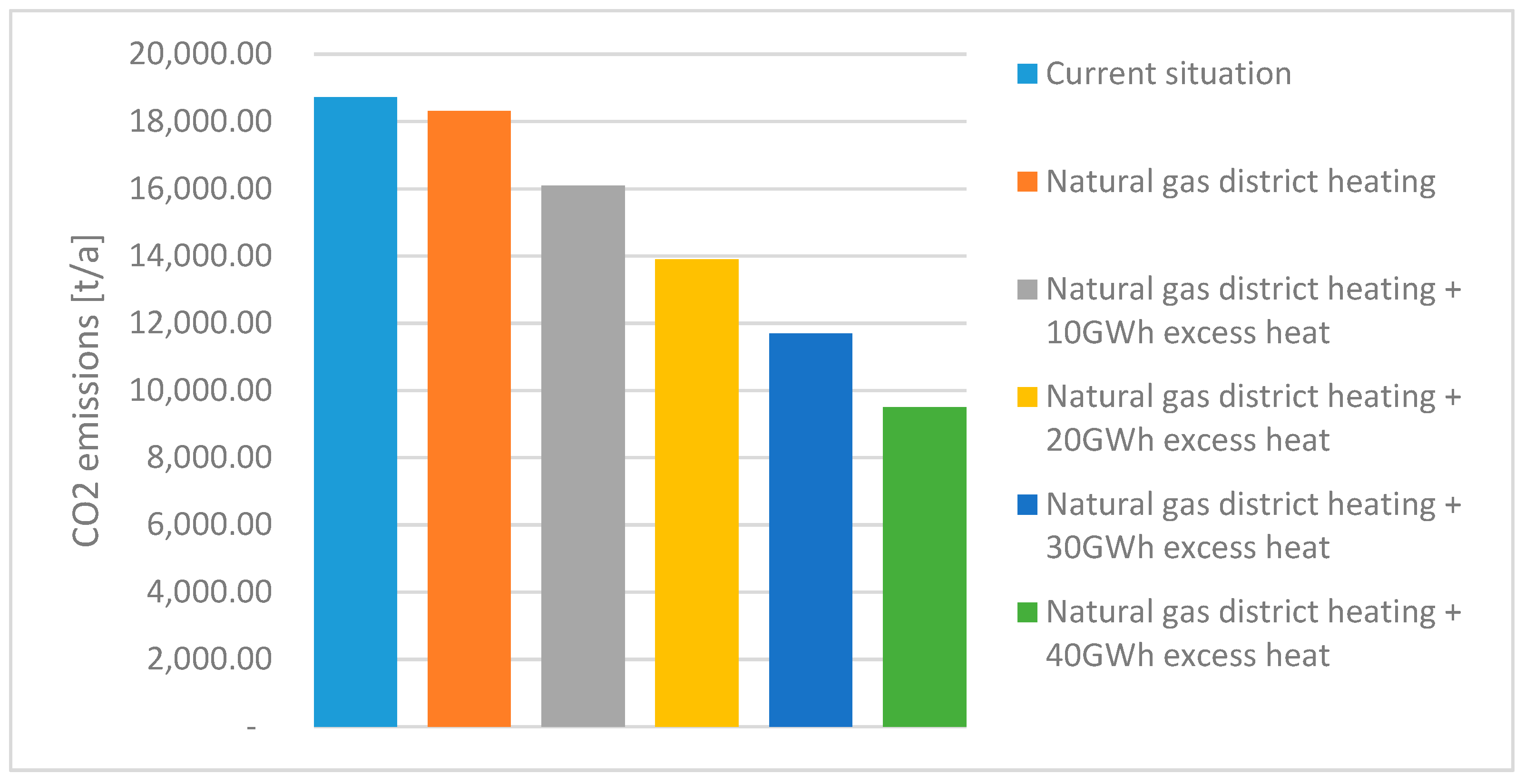Evaluation of Excess Heat Utilization in District Heating Systems by Implementing Levelized Cost of Excess Heat
Abstract
1. Introduction
2. Materials and Methods
2.1. Heat Demand Mapping
- The first step was to create a matrix in Matlab that contained information on the total gross area and locations of buildings from the Croatian online building census Geoportal [46].
- In the second stage, the buildings were classified into eight categories according to their purpose and condition, in order to allocate their specific heat demands.
- At the same time, data on the number of floors were collected by visually inspecting all the households in the analyzed area. This could be done by using free online tools like Google Earth, etc. Both the categories and the number of floors were added to the initial matrix by color coding.
- Afterwards, the final heat demand matrix was created by multiplying the total gross areas of the buildings with the associated specific heat demands. This final matrix was then transferred into a geographic information system interface using the QGIS tool.
2.2. Scenario Analysis
2.2.1. Implementation of a Natural Gas District Heating System
2.2.2. Integrating Excess Heat into the District Heating System
3. Results
4. Discussion and Concluding Remarks
Acknowledgments
Author Contributions
Conflicts of Interest
References
- Connolly, D.; Lund, H.; Mathiesen, B.V.; Werner, S.; Möller, B.; Persson, U.; Boermans, T.; Trier, D.; Østergaard, P.A.; Nielsen, S. Heat roadmap Europe: Combining district heating with heat savings to decarbonise the EU energy system. Energy Policy 2014, 65, 475–489. [Google Scholar] [CrossRef]
- Werner, S. District heating and cooling in Sweden. Energy 2017, 126, 419–429. [Google Scholar] [CrossRef]
- Lund, H.; Möller, B.; Mathiesen, B.V.; Dyrelund, A. The role of district heating in future renewable energy systems. Energy 2010, 35, 1381–1390. [Google Scholar] [CrossRef]
- Grundahl, L.; Nielsen, S.; Lund, H.; Möller, B. Comparison of district heating expansion potential based on consumer-economy or socio-economy. Energy 2016, 115, 1771–1778. [Google Scholar] [CrossRef]
- Ahvenniemi, H.; Klobut, K. Future Services for District Heating Solutions in Residential Districts. J. Sustain. Dev. Energy Water Environ. Syst. 2014, 2, 127–138. [Google Scholar] [CrossRef][Green Version]
- Paiho, S.; Reda, F. Towards next generation district heating in Finland. Renew. Sustain. Energy Rev. 2016, 65, 915–924. [Google Scholar] [CrossRef]
- Calise, F.; D’Accadia, M.D.; Barletta, C.; Battaglia, V.; Pfeifer, A.; Duic, N. Detailed Modelling of the Deep Decarbonisation Scenarios with Demand Response Technologies in the Heating and Cooling Sector: A Case Study for Italy. Energies 2017, 10, 1535. [Google Scholar] [CrossRef]
- Lund, H.; Werner, S.; Wiltshire, R.; Svendsen, S.; Thorsen, J.; Hvelplund, F.; Mathiesen, B.V. 4th Generation District Heating (4GDH). Energy 2014, 68, 1–11. [Google Scholar] [CrossRef]
- Sayegh, M.A.; Danielewicz, J.; Nannou, T.; Miniewicz, M.; Jadwiszczak, P.; Piekarska, K.; Jouhara, H. Trends of European research and development in district heating technologies. Renew. Sustain. Energy Rev. 2016, 68, 1183–1192. [Google Scholar] [CrossRef]
- Mikulandrić, R.; Krajačič, G.; Duić, N.; Khavin, G.; Lund, H.; Mathiesen, B.V. Performance Analysis of a Hybrid District Heating System: A Case Study of a Small Town in Croatia. J. Sustain. Dev. Energy Water Environ. Syst. 2015, 3, 282–302. [Google Scholar] [CrossRef]
- Čulig-Tokić, D.; Krajačić, G.; Doračić, B.; Mathiesen, B.V.; Krklec, R.; Larsen, J.M. Comparative analysis of the district heating systems of two towns in Croatia and Denmark. Energy 2015, 92, 435–443. [Google Scholar] [CrossRef]
- Basciotti, D.; Schmidt, R.R.; Meissner, E.; Doczekal, C.; Giovannini, A. Low temperature district heating in Austria: Energetic, ecologic and economic comparison of four case studies. Energy 2016, 110, 95–104. [Google Scholar]
- Noussan, M. Performance indicators of District Heating Systems in Italy—Insights from a data analysis. Appl. Therm. Eng. 2018, 134, 194–202. [Google Scholar] [CrossRef]
- Rosa, A.D.; Boulter, R.; Church, K.; Svendsen, S. District heating (DH) network design and operation toward a system-wide methodology for optimizing renewable energy solutions (SMORES) in Canada: A case study. Energy 2012, 45, 960–974. [Google Scholar] [CrossRef]
- Lund, R.; Mohammadi, S. Choice of insulation standard for pipe networks in 4th generation district heating systems. Appl. Therm. Eng. 2016, 98, 256–264. [Google Scholar] [CrossRef]
- Lian, H.K.; Li, Y.; Shu, G.Y.Z.; Gu, C.W. An overview of domestic technologies for waste heat utilization. Energy Conserv. Technol. 2011, 29, 123–128. [Google Scholar]
- Werner, S. Ecoheatcool: The European Heat Market. 2006. Available online: https://www.euroheat.org/wp-content/uploads/2016/02/Ecoheatcool_WP1_Web.pdf (accessed on 7 March 2018).
- Persson, U.; Möller, B.; Werner, S. Heat Roadmap Europe: Identifying strategic heat synergy regions. Energy Policy 2014, 74, 663–681. [Google Scholar] [CrossRef]
- Colmenar-santos, A.; Rosales-asensio, E.; Borge-diez, D.; Blanes-peiró, J. District heating and cogeneration in the EU-28: Current situation, potential and proposed energy strategy for its generalisation. Renew. Sustain. Energy Rev. 2016, 62, 621–639. [Google Scholar] [CrossRef]
- Fang, H.; Xia, J.; Zhu, K.; Su, Y.; Jiang, Y. Industrial waste heat utilization for low temperature district heating. Energy Policy 2013, 62, 236–246. [Google Scholar] [CrossRef]
- Morandin, M.; Hackl, R.; Harvey, S. Economic feasibility of district heating delivery from industrial excess heat: A case study of a Swedish petrochemical cluster. Energy 2014, 65, 209–220. [Google Scholar] [CrossRef]
- Dou, Y.; Togawa, T.; Dong, L.; Fujii, M.; Ohnishi, S.; Tanikawa, H.; Fujita, T. Innovative planning and evaluation system for district heating using waste heat considering spatial configuration: A case in Fukushima, Japan. Resour. Conserv. Recycl. 2018, 128, 406–416. [Google Scholar] [CrossRef]
- Lund, R.; Persson, U. Mapping of potential heat sources for heat pumps for district heating in Denmark. Energy 2016, 110, 129–138. [Google Scholar] [CrossRef]
- Cooper, S.J.G.; Hammond, G.; Norman, J. Potential for use of heat rejected from industry in district heating networks, GB perspective. J. Energy Inst. 2016, 1, 57–69. [Google Scholar] [CrossRef]
- Chiu, J.N.W.; Flores, J.C.; Martin, V.; Lacarriere, B. Industrial surplus heat transportation for use in district heating. Energy 2016, 110, 139–147. [Google Scholar] [CrossRef]
- Zhang, Y.; Zhang, Y.; Shi, W.; Wang, X. Application of concept of heat adaptor: Determining an ideal central heating system using industrial waste heat. Appl. Therm. Eng. 2016. [Google Scholar] [CrossRef]
- Viklund, S.B.; Karlsson, M. Industrial excess heat use: Systems analysis and CO2 emissions reduction. Appl. Energy 2015, 152, 189–197. [Google Scholar] [CrossRef]
- Weinberger, G.; Amiri, S.; Moshfegh, B. On the benefit of integration of a district heating system with industrial excess heat: An economic and environmental analysis. Appl. Energy 2017, 191, 454–468. [Google Scholar] [CrossRef]
- Eriksson, L.; Morandin, M.; Harvey, S. Targeting capital cost of excess heat collection systems in complex industrial sites for district heating applications. Energy 2015, 91, 465–478. [Google Scholar] [CrossRef]
- Ekvall, T.; Ahlgren, E.O.; Fakhri, A.; Martin, B. Modelling environmental and energy system impacts of large-scale excess heat utilisation e A regional case study. Energy 2015, 79, 68–79. [Google Scholar]
- Geissmann, T. A probabilistic approach to the computation of the levelized cost of electricity. Energy 2017, 124, 372–381. [Google Scholar] [CrossRef]
- Guo, P.; Zhai, Y.; Xu, X.; Li, Y. Assessment of levelized cost of electricity for a 10-MW solar chimney power plant in Yinchuan China. Energy Convers. Manag. 2017, 152, 176–185. [Google Scholar] [CrossRef]
- Picard, D.; Helsen, L. Economic Optimal HVAC Design for Hybrid GEOTABS Buildings and CO2 Emissions Analysis. Energies 2018, 11, 314. [Google Scholar] [CrossRef]
- Hansen, K.; Connolly, D.; Lund, H.; Drysdale, D.; Thellufsen, J.Z. Heat Roadmap Europe: Identifying the balance between saving heat and supplying heat. Energy 2016, 115, 1663–1671. [Google Scholar] [CrossRef]
- Gabbrielli, R.; Castrataro, P.; del Medico, F.; di Palo, M.; Lenyo, P. Levelized Cost of Heat for Linear Fresnel Concentrated Solar Systems. Energy Procedia 2014, 49, 1340–1349. [Google Scholar] [CrossRef]
- Fawzy, M.; Kazulis, V.; Veidenbergs, I.; Blumberga, D. Levelized cost of energy analysis of co-firing solid, liquid and gaseous fuel. Energy Procedia 2017, 128, 202–207. [Google Scholar] [CrossRef]
- Wahlroos, M.; Matti, P.; Manner, J.; Syri, S. Utilizing data center waste heat in district heating—Impacts on energy efficiency and prospects for low-temperature district heating networks. Energy 2017, 140, 1228–1238. [Google Scholar] [CrossRef]
- Broberg, S.; Backlund, S.; Karlsson, M.; Thollander, P. Industrial excess heat deliveries to Swedish district heating networks: Drop it like it’s hot. Energy Policy 2012, 51, 332–339. [Google Scholar] [CrossRef]
- Doračić, B.; Novosel, T.; Pukšec, T. Novel approach for the evaluation of excess heat utilization in small district heating systems. In Proceedings of the 12th Conference on Sustainable Development of Energy, Water and Environment Systems (SDEWES), Dubrovnik, Croatia, 4–8 October 2017. [Google Scholar]
- Wyrwa, A.; Chen, Y. Mapping Urban Heat Demand with the Use of GIS-Based Tools. Energies 2017, 10, 5. [Google Scholar]
- The MathWorks Inc. MATLAB; The MathWorks Inc.: Natick, MA, USA, 2016. [Google Scholar]
- QGIS. A Free and Open Source Geographic Information System. 2018. Available online: https://www.qgis.org/en/site/ (accessed on 7 March 2018).
- Pukšec, T.; Duić, N.; Sunko, R.; Mataradžija, M.; Fejzović, E.; Babić, A.; Gjorgievski, V.; Dimov, L.J.; Bozhikaliev, V.; Markovska, M.; et al. Survey on the Energy Consumption and Attitudes towards Renewable Heating and Cooling in the CoolHeating Target Communities. 2016. Available online: http://www.coolheating.eu/images/downloads/CoolHeating_Survey_3.4.pdf (accessed on 7 March 2018).
- Rutz, D.; Rutz, D.; Janssen, R.; Ugalde, J.M.; Hofmeister, M.; Sorensen, P.A.; Jensen, L.L.; Doczekal, C.; Zweiler, R.; Pukšec, T.; et al. Small, modular and renewable district heating & cooling grids for communities in South-Eastern Europe. Eur. Biomass Conf. Exhib. Proc. 2016, 2016, 1654–1659. [Google Scholar]
- Domac, J.; Kolega, V.; Djukić, S.; Horvat, I.; Lončar, I.; Maras, H.; Pržulj, I.; Šegon, V.; Cvijak, V. Akcijski Plan Energetski Održivog Razvitka Grada Ozlja. 2009. Available online: http://www.eko.zagreb.hr/UserDocsImages/dokumenti/seap-i%20hr%20gradova/SEAP_OZALJ_radna%20verzija_fin.pdf (accessed on 7 March 2018).
- Geoportal—Državna Geodetska Uprava. 2018. Available online: https://geoportal.dgu.hr/ (accessed on 7 March 2018).
- Technology Data for Energy Plants. 2012. Available online: https://energiatalgud.ee/img_auth.php/4/42/Energinet.dk._Technology_Data_for_Energy_Plants._2012.pdf (accessed on 7 March 2018).
- Levelized Cost Calculations. Available online: http://en.openei.org/apps/TCDB/levelized_cost_calculations.html (accessed on 5 March 2018).
- Doračić, B.; Pušić, T.; Novosel, T.; Pavičević, M.; Pukšec, T.; Duić, N. Techno-Economic Analysis of the Implementation of a Small Renewable District Heating System: Case Study for the City of Ozalj. In Proceedings of the 5th International Congress Mechanical Engineers Day, Amman, Jordan, 13–16 May 2017; pp. 27–32. [Google Scholar]





| Category | Number of Buildings Analyzed in the Survey | Specific Heat Demand (kWh/m2) | Standard Deviation from the Mean Specific Heat Demand (159.2 kWh/m2) |
|---|---|---|---|
| Old house | 241 | 177.75 | 18.56 |
| New house | 12 | 112.5 | −46.69 |
| House without insulation | 28 | 262.5 | 103.31 |
| Apartment building | 21 apartments | 161.25 | 2.06 |
| Office building | - | 135 | −24.19 |
| Public building | - | 270 | 110.81 |
| Historic building | - | 78.75 | −80.44 |
| Industry | - | 110 | −49.19 |
| Heat Demand (MWh) | 75,383.00 |
| Gross household area (m2) | 357,674.00 |
| Number of 100 × 100 m areas | 92 |
| Excess Heat Price [€/MWh] | Cost of Distribution Pipes [€/m] | Available Excess Heat Supply (GWh) |
|---|---|---|
| 1 | 200 | 10 |
| 2 | 400 | 20 |
| 3 | 600 | 30 |
| 4 | 800 | 40 |
| Current Situation | Natural Gas District Heating | Natural Gas District Heating + 40 GWh Excess Heat | |
|---|---|---|---|
| NOx emissions (kg/a) | 25,783.24 | 3292.07 | 1707.62 |
| PM emissions (kg/a) | 1,331,938.62 | 29.93 | 15.52 |
| CO emissions (kg/a) | 2,153,771.65 | 70,013.02 | 36,316.36 |
© 2018 by the authors. Licensee MDPI, Basel, Switzerland. This article is an open access article distributed under the terms and conditions of the Creative Commons Attribution (CC BY) license (http://creativecommons.org/licenses/by/4.0/).
Share and Cite
Doračić, B.; Novosel, T.; Pukšec, T.; Duić, N. Evaluation of Excess Heat Utilization in District Heating Systems by Implementing Levelized Cost of Excess Heat. Energies 2018, 11, 575. https://doi.org/10.3390/en11030575
Doračić B, Novosel T, Pukšec T, Duić N. Evaluation of Excess Heat Utilization in District Heating Systems by Implementing Levelized Cost of Excess Heat. Energies. 2018; 11(3):575. https://doi.org/10.3390/en11030575
Chicago/Turabian StyleDoračić, Borna, Tomislav Novosel, Tomislav Pukšec, and Neven Duić. 2018. "Evaluation of Excess Heat Utilization in District Heating Systems by Implementing Levelized Cost of Excess Heat" Energies 11, no. 3: 575. https://doi.org/10.3390/en11030575
APA StyleDoračić, B., Novosel, T., Pukšec, T., & Duić, N. (2018). Evaluation of Excess Heat Utilization in District Heating Systems by Implementing Levelized Cost of Excess Heat. Energies, 11(3), 575. https://doi.org/10.3390/en11030575






